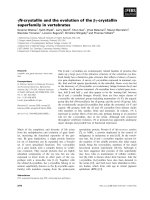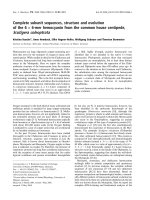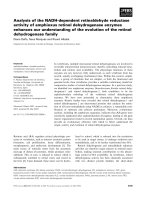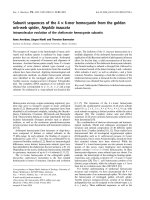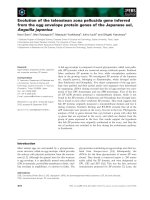Evolution of the earth
Bạn đang xem bản rút gọn của tài liệu. Xem và tải ngay bản đầy đủ của tài liệu tại đây (7.55 MB, 55 trang )
Copyright ©The McGraw-Hill Companies, Inc. Permission required for reproduction or display.
Evolution of the
Earth
Seventh Edition
Prothero • Dott
Chapter 8
Cryptozoic History: Introduction to the Origin of Continental Crust
Figure 4.7
Figure 4.8
Complete Geologic Time Scale
Hadean to Recent
Phanerozoic –
“visible life”
Geologic Time Scale for 1st 3.8 Billion Years of Earth Existence
Proterozoic - “hidden life”
Archean – life first appears (?) and remains viable
Hadean – meteorite bombardment, life started and restarted?
Chap. 8 - Origin of Continental Crust
• Main Topics
– Earth cooled sufficiently to
permit formation of early
continental (granitic) material
– Isotopic age dates within
continents “cluster”
suggesting several periods of
“orogeny”
– Early continents seem to
represent “partial melts” of
andesitic volcanics or early
sediments.
– Most of the present-day
volume of continental
material had formed by ~2.5
billion yrs. ago.
Chap. 8 - Origin of Continental Crust
•
Main Topics (cont.)
– Archean (3800 – 2500 Bya) rocks
characterized by “greenstone”
belts and texturally immature
sediments (graywackes), largely
form oceanic arcs. Suggesting
plate tectonics may have started?
– Proterozoic (2500 – 540 Bya)
rocks are texturally and
compositionally mature, include
chemical sediments (carbonates
and evaporites). Stromatolites are
present showing life had evolved
while evaporites suggest that sea
water had also evolved to its
present composition
Fig. 8.1
Atrists conception of what surface of
earth looked like during its first 500
million years.
Surface was largely molten, with a few of
the original microcontinents beginning to
form.
Intense meteorite bombardment heated
surface to melting.
Moon was twice as close, exerting a very
strong gravitational pull.
Early atmosphere had no O2, but probably
consisted of N2, CH4, NH3, CO2 and H2O.
Note no oceans.
Evidence of Crustal Development from Igneous
and Metamorphic Rocks
•
Importance of Granite
•
Rock-types surviving from early Cryptozic are mainly granitic in
composition and they are arrangemed in highly deformed orogenic belts.
•
This has led to hypothesis of continential accretion of early granitic masses
into protocontinents and then continents.
Evidence of Crustal Development from Igneous
and Metamorphic Rocks
• However field evidence suggests that granitic
continental crust was not original and must have
increased in volume through time.
• Original crust was thin and mainly basalt.
Weathering, erosion and igneous activity converted
some of the original crust to granite to form
embryonic continents.
• Embryonic continents persisted on surface of earth
and accreted slowly to form larger continents.
Fig. 8.10
Archean granite (light) intruding metavolcanic
(metamorphosed volcanic ash, etc.) sediments. Nestor
Falls. Ontario. Granite is about 2.5 By (Algoman
orogeny).
Fig. 8.2
Cryptozoic (“hidden life”) Eon
Sondre Stromfjord,
SW Greenland.
Age of rocks in this
picture are ~3.8 By.
High-grade metamorphic rock (gneiss) typical
of ancient “shield” regions.
Fig. 8.6
Cross-section from N. Shore of L. Superior to northern Michigan.
Numbers refer to relative age (1 = oldest).
Development of a Cryptozoic Chronology
•
Age dating of ancient rocks showed patterns of old rocks bounded by
younger rocks in patterns that suggested accretion of younger material
onto a core of older, mostly granitic, rock.
• Thus the modern continents have a history of growth by addition of
smaller granitic masses, which persisted through time because of their
greater buoyancy.
Fig. 8.3
Map showing locations of all Cryptozoic and early Paleozoic rocks in
the world. Numbers refer to age in By.
Fig. 8.11
These geologic
provinces form the core
of the North American
craton.
The older rocks
probably accreted about
1.8 - 1.9 Bya. The
Grenville Province was
sutured about 1.0 Bya.
(craton = stable nucleus
of a continent)
Isotopic age dates show great discordance when
mapped over the entire N. American craton.
Greenstone Belts
• “Greenstone Belts” are basically metamorphosed
basalts and graywacke (discussed below) sandstones
deposited as pillow lavas and turbidity flows on the
floors of ancient seas.
• When protocontinents collided and accreted, the
ocean floors filled with these basalts and graywackes
collapsed, forming greenstone belts that also accreted
to the growing protocontinent.
• Thus some of the early seafloor survived destruction
(by subduction) and became part of the stable craton.
Fig. 8.12
Evolution of greenstone belts. A. Basins between protocontinents fill
with basalts, B. when protocontinents collide, they “collapse” the
oceans filled with basalts and graywackes, forming greenstone belts.
Fig. 8.13
Hypothetical scenario for assembly of N. American craton during
Proterozoic. Based on dates and tectonic patterns in previous
figure.
Interpretation of Crustal Development from
Sediments
•
Terrigenous vs. nonterrigenous sediments
•
Composition of sedimentary rock reflects source
– Clastic sediments – primarily silicates, derived from erosion of older rocks in
land areas
– Chemical sediments – evaporites (salt – NaCl, gypsum – CaSO4) and
carbonates. Precipitates or bio-precipitates in warm, shallow seas
Fig. 8.14
Stages in the development of textural maturity in a sand through
abrasion and sorting of grains. Size tends to decrease with time and
transport distance. Clay minerals form, from from chemically
unstable minerals such as feldspars and amphiboles and quartz is
concentrated in residue. Final stage is a pure quartz sandstone, but
often only after several tectonic (erosion, burial, uplift) cycles.
Fig. 8.15
graywacke
arkose
quartzite
Steps in the evolution of a mature sand from initial weathering of a granite.
Texturally mature sand is mono-minerallic (quartz), well-rounded and of a uniform
grain size. This indicates a long time spent in transport or washing around on a
beach. It may also be 2nd or even 3rd cycle. Graywacke suggests rapid transport
and burial (why?) while arkosic sands suggest longer transport or more intense
weathering in place, since most unstable minerals (amphiboles) are missing.
Fig. 8.16a
Photomicrograph of a
graywacke sandstone showing
lack of textural maturity
(angular grains, many
unstable minerals and poor
sorting (a wide range of grain
sizes.
This rock is 1st cycle,
deposited rapidly, perhaps as
a turbidite and spent little or
no time in a high-energy
environment such as a beach.
This type of rock would be
expected to be common on
the early (Archean) earth.
Fig. 8.8a
Graded bedding (grain size decreases upward in the gray
beds) in Archean graywacke from Ely, Mn.
Fig. 8.8b
Archean graywacke
showing multiple graded
beds and interstratified
limestones.
East of Great Slave Lake,
Northwest Territories,
Canada.


